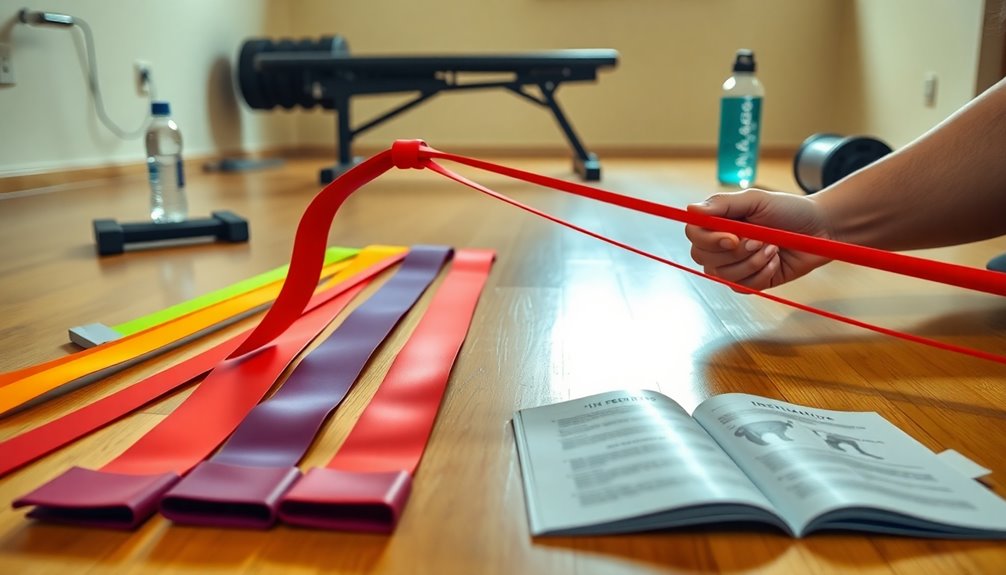Resistance bands play an essential role in your strength training by enhancing muscle activation and allowing for constant tension throughout exercises. They're versatile and can be used anywhere, making them perfect for all fitness levels. You can choose from flat bands, loop bands, and tube bands to target different muscle groups effectively. Incorporating these bands into your routine supports progressive overload, essential for muscle growth. Plus, they're cost-effective and safe when used correctly. If you're curious about specific techniques and safety measures for using resistance bands, there's plenty more to learn that can boost your training efficiency.
Key Takeaways
- Resistance bands enhance strength training by promoting muscle activation and supporting progressive overload for effective muscle growth.
- They provide constant tension throughout exercises, improving muscle strength, endurance, and flexibility.
- Resistance bands are versatile and portable, making them suitable for all fitness levels and easy to use at home or while traveling.
- Various types of bands can be integrated into workouts, allowing for targeted exercises for different muscle groups and combining with other equipment.
- They contribute to overall well-being by boosting mood, managing stress, and fostering social connections with fitness enthusiasts.
Benefits of Resistance Bands

Resistance bands are a versatile tool that can elevate your strength training routine. Whether you're a seasoned athlete or just starting out, these bands offer unique benefits that can enhance your workouts. One of the key advantages is their ability to promote muscle activation. Unlike traditional weights, resistance bands provide a constant tension throughout the exercise. This means your muscles are engaged more thoroughly, helping you build strength and improve overall performance.
Another significant benefit is their role in progressive overload. To effectively build muscle, you need to challenge your body gradually. Resistance bands allow you to easily increase the tension as you get stronger. You can simply switch to a thicker band or adjust your grip to create more resistance. This adaptability means you'll always be pushing your limits, which is essential for muscle growth.
Moreover, resistance bands are incredibly portable and can be used in various settings—at home, in the park, or even while traveling. You don't need a gym membership to access their benefits, making it easier to stay consistent with your training. Plus, they're perfect for all fitness levels, so you can work out alongside friends or family, fostering a sense of community and support. Additionally, the use of mini bands can provide a unique challenge with elastic resistance, enhancing your muscle toning even further.
Incorporating resistance bands into your strength training routine not only enhances your workouts but also helps you create a more inclusive and motivating environment for you and those around you. So grab a band, and let's get started on your strength journey together!
Types of Resistance Bands

When it comes to strength training, understanding the different types of resistance bands can help you choose the right ones for your workouts. There are several resistance band variations available, each designed to target specific muscles and accommodate various workout styles.
First, you'll find flat bands, which are often used for physical therapy and rehabilitation. These bands are great for low-impact resistance band exercises, making them perfect for beginners or those recovering from injuries.
Next up are loop bands, which come in various thicknesses and are fantastic for lower body workouts. You can use these for squats, leg presses, or glute bridges, enhancing your strength effectively.
Another popular option is the tube bands, which have handles on either end. They're versatile and easy to use, allowing you to perform a wide range of resistance band exercises for both upper and lower body. These bands are especially effective for targeting your arms, shoulders, and chest.
Lastly, you might consider fabric bands, which are thicker and often used for more intense workouts. These bands provide a different feel and can help you engage your muscles more deeply during exercises like hip thrusts or lateral walks. This deep engagement is crucial for proper glute development, as it ensures that all glute muscles are activated during your training.
With so many resistance band variations at your disposal, you can mix and match to create a dynamic strength training routine that suits your preferences and goals. So, explore these options and find what resonates with you the most!
Integrating Bands Into Workouts

Often, incorporating resistance bands into your workouts can elevate your strength training routine. You can easily enhance your exercises by choosing from various band variations, which offer unique resistance levels and training opportunities.
For example, lighter bands are great for warming up or focusing on smaller muscle groups, while heavier bands can challenge larger muscle groups, pushing you to grow stronger.
To maximize the effectiveness of your sessions, consider band pairings. Pairing bands with free weights or bodyweight exercises can create a more inclusive workout.
For instance, attach a band to a sturdy anchor while performing squats or lunges; this combination enhances your stability and engages your muscles differently, leading to better results.
Additionally, integrating bands into your warm-ups or cool-downs can help improve your flexibility and mobility, setting you up for success during more intense workouts.
Simple movements, like banded shoulder stretches or lateral leg raises, can warm up those essential muscles and prepare them for action. Furthermore, similar to Crunchless Core's focus on spine-friendly exercises(#), resistance bands can help ensure your movements are safe and effective.
Don't hesitate to experiment with different band variations and pairings to find what works best for you. This exploration not only keeps your workouts fresh and exciting but also fosters a sense of community among fellow fitness enthusiasts.
Sharing your band experiences with friends or online groups can inspire others to join you on your strength training journey. Embrace the versatility of resistance bands, and let them transform your workout routine!
Techniques for Effective Training

Achieving success in strength training hinges on the techniques you use during your workouts. When it comes to resistance bands, implementing effective methods can greatly enhance your results. Here are some key techniques to keep in mind:
- Focus on Progressive Overload: Gradually increase the resistance you're using. This could mean moving to a thicker band or adding more repetitions. Progressive overload is crucial for muscle growth and strength gains.
- Maintain Proper Form: Always prioritize technique over the amount of resistance. Using proper form ensures you're targeting the correct muscle groups and reduces the risk of injury. Pay attention to your body alignment and engage your core throughout each movement.
- Vary Your Exercises: Mix up your routine by incorporating different exercises that target various muscle groups. Resistance bands are versatile, allowing you to perform everything from squats to rows, ensuring your workouts remain engaging and effective.
- Incorporate Time Under Tension: Slow down your movements to increase time under tension for your muscles. This helps stimulate growth and enhances strength. Try holding the peak contraction for a moment before releasing. Additionally, combining resistance band exercises with pre-habilitation techniques can further improve your overall strength training outcomes.
Safety Tips for Using Bands

Using resistance bands can be an excellent way to enhance your strength training, but prioritizing safety is vital to avoid injuries. It's crucial to begin with proper form to make sure you're maximizing your workout while reducing risk. Always maintain a strong posture, keeping your core engaged and your back straight. This approach helps you concentrate on the targeted muscles without straining others.
Before you start, inspect your bands for any signs of wear and tear. Frayed or damaged bands can snap during use, leading to potential injuries. If you notice any issues, it's ideal to replace them.
When selecting a resistance band, choose one that suits your fitness level. If you're just starting, lighter bands are a great choice, enabling you to develop strength gradually.
While using the bands, avoid sudden movements. Instead, perform exercises in a controlled manner, focusing on the muscles you're targeting. This allows for better engagement and injury prevention. Pay attention to your body; if you experience any sharp pain or discomfort, stop immediately and reassess your technique.
Lastly, remember to warm up before your workout and stretch afterward. These practices not only improve your performance but also contribute to injury prevention. By following these safety suggestions, you'll establish a strong foundation for your resistance band training while enjoying the journey alongside others who share your fitness goals. Additionally, incorporating mind/body exercises can further enhance your overall well-being and help manage stress levels.
Frequently Asked Questions
Can Resistance Bands Replace Free Weights Entirely?
You might wonder if resistance bands can fully replace free weights. While bands offer unique benefits like improved strength balance and muscle activation, they're not a complete substitute.
Free weights allow for a broader range of exercises and heavier loads, which can be essential for building muscle. Using both in your routine can enhance your workouts, ensuring you engage different muscle groups effectively.
Embrace variety to achieve your fitness goals!
How Do Resistance Bands Improve Flexibility?
Imagine yourself gliding through a yoga pose, your body flowing like water. Resistance bands can enhance your flexibility by providing gentle tension, allowing you to stretch deeper without overstretching.
For runners, incorporating bands into your routine helps loosen tight muscles and improve range of motion. You'll feel more connected to your body, enhancing your overall performance.
Embracing resistance bands in your practice not only boosts flexibility but also fosters a sense of belonging in your fitness journey.
Are Resistance Bands Suitable for Rehabilitation Purposes?
Yes, resistance bands are great for rehabilitation purposes. They help with athlete recovery by providing a controlled way to engage muscles without putting too much strain on your body.
You'll find that they enhance muscle activation, allowing you to target specific areas and gradually build strength. Plus, their versatility makes them perfect for various exercises, ensuring you can adapt your routine as you progress.
You'll feel empowered as you regain your strength and mobility!
What Is the Lifespan of Resistance Bands?
Imagine your favorite rubber band, stretched and worn from countless uses.
Resistance bands typically last between six months to two years, depending on their durability and how well you care for them. To extend their life, avoid exposing them to extreme temperatures and sunlight, and store them properly.
Keep an eye out for wear and tear—when they start losing elasticity, it's time for a replacement. Regular maintenance can make a big difference!
Can Children Use Resistance Bands Safely?
Yes, children can use resistance bands safely, but you need to guarantee child safety through proper supervision. Start with light resistance bands and teach them the correct techniques. Encourage fun, engaging exercises that promote strength without overexertion.
Always watch for signs of fatigue or discomfort, and adjust their routine accordingly. With your guidance, they can enjoy the benefits of resistance bands while developing healthy habits and building confidence in their physical abilities.
Conclusion
Incorporating resistance bands into your strength training routine can feel like discovering the secret sauce to superhero strength! With their versatility, you can sculpt every muscle, reveal your inner athlete, and maybe even challenge gravity itself. By blending these bands into your workouts, you'll not only boost your performance but also enjoy every minute of your training. So, grab those bands, channel your inner fitness warrior, and watch as you transform into the strongest version of yourself—no cape required!



